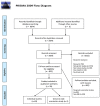Genetic susceptibility in Juvenile Myoclonic Epilepsy: Systematic review of genetic association studies
- PMID: 28636645
- PMCID: PMC5479548
- DOI: 10.1371/journal.pone.0179629
Genetic susceptibility in Juvenile Myoclonic Epilepsy: Systematic review of genetic association studies
Abstract
Background: Several genetic association investigations have been performed over the last three decades to identify variants underlying Juvenile Myoclonic Epilepsy (JME). Here, we evaluate the accumulating findings and provide an updated perspective of these studies.
Methodology: A systematic literature search was conducted using the PubMed, Embase, Scopus, Lilacs, epiGAD, Google Scholar and Sigle up to February 12, 2016. The quality of the included studies was assessed by a score and classified as low and high quality. Beyond outcome measures, information was extracted on the setting for each study, characteristics of population samples and polymorphisms.
Results: Fifty studies met eligibility criteria and were used for data extraction. With a single exception, all studies used a candidate gene approach, providing data on 229 polymorphisms in or near 55 different genes. Of variants investigating in independent data sets, only rs2029461 SNP in GRM4, rs3743123 in CX36 and rs3918149 in BRD2 showed a significant association with JME in at least two different background populations. The lack of consistent associations might be due to variations in experimental design and/or limitations of the approach.
Conclusions: Thus, despite intense research evidence established, specific genetic variants in JME susceptibility remain inconclusive. We discussed several issues that may compromise the quality of the results, including methodological bias, endophenotype and potential involvement of epigenetic factors.
Prospero registration number: CRD42016036063.
Conflict of interest statement
Figures

Similar articles
-
Systemic pharmacological treatments for chronic plaque psoriasis: a network meta-analysis.Cochrane Database Syst Rev. 2021 Apr 19;4(4):CD011535. doi: 10.1002/14651858.CD011535.pub4. Cochrane Database Syst Rev. 2021. Update in: Cochrane Database Syst Rev. 2022 May 23;5:CD011535. doi: 10.1002/14651858.CD011535.pub5. PMID: 33871055 Free PMC article. Updated.
-
Measures implemented in the school setting to contain the COVID-19 pandemic.Cochrane Database Syst Rev. 2022 Jan 17;1(1):CD015029. doi: 10.1002/14651858.CD015029. Cochrane Database Syst Rev. 2022. Update in: Cochrane Database Syst Rev. 2024 May 2;5:CD015029. doi: 10.1002/14651858.CD015029.pub2. PMID: 35037252 Free PMC article. Updated.
-
Cost-effectiveness of using prognostic information to select women with breast cancer for adjuvant systemic therapy.Health Technol Assess. 2006 Sep;10(34):iii-iv, ix-xi, 1-204. doi: 10.3310/hta10340. Health Technol Assess. 2006. PMID: 16959170
-
Drugs for preventing postoperative nausea and vomiting in adults after general anaesthesia: a network meta-analysis.Cochrane Database Syst Rev. 2020 Oct 19;10(10):CD012859. doi: 10.1002/14651858.CD012859.pub2. Cochrane Database Syst Rev. 2020. PMID: 33075160 Free PMC article.
-
Topiramate for juvenile myoclonic epilepsy.Cochrane Database Syst Rev. 2021 Nov 24;11(11):CD010008. doi: 10.1002/14651858.CD010008.pub5. Cochrane Database Syst Rev. 2021. PMID: 34817852 Free PMC article.
Cited by
-
Juvenile myoclonic epilepsy has hyper dynamic functional connectivity in the dorsolateral frontal cortex.Neuroimage Clin. 2019;21:101604. doi: 10.1016/j.nicl.2018.11.014. Epub 2018 Nov 19. Neuroimage Clin. 2019. PMID: 30527355 Free PMC article.
-
Association of GABAA Receptor Gene with Epilepsy Syndromes.J Mol Neurosci. 2018 Jun;65(2):141-153. doi: 10.1007/s12031-018-1081-7. Epub 2018 May 21. J Mol Neurosci. 2018. PMID: 29785705
-
Association of variants in the ABCB1, CYP2C19 and CYP2C9 genes for Juvenile Myoclonic Epilepsy.Neurol Sci. 2024 Apr;45(4):1635-1643. doi: 10.1007/s10072-023-07124-w. Epub 2023 Oct 25. Neurol Sci. 2024. PMID: 37875597
-
Novel SCN2A mutation in a family associated with juvenile-onset myoclonus: Case report.Medicine (Baltimore). 2019 Feb;98(8):e14698. doi: 10.1097/MD.0000000000014698. Medicine (Baltimore). 2019. PMID: 30813219 Free PMC article.
-
A systematic review and meta-analysis of factors related to first line drugs refractoriness in patients with juvenile myoclonic epilepsy (JME).PLoS One. 2024 Apr 9;19(4):e0300930. doi: 10.1371/journal.pone.0300930. eCollection 2024. PLoS One. 2024. PMID: 38593118 Free PMC article.
References
-
- Genton P, Gelisse P. The history of juvenile myoclonic epilepsy. Epilepsy Behav. 2013;28 Suppl 1: S2–7. doi: 10.1016/j.yebeh.2013.01.002 - DOI - PubMed
-
- Proposal for revised classification of epilepsies and epileptic syndromes. Commission on Classification and Terminology of the International League Against Epilepsy. Epilepsia. 30: 389–99. Available: http://www.ncbi.nlm.nih.gov/pubmed/2502382 - PubMed
-
- Berg AT, Berkovic SF, Brodie MJ, Buchhalter J, Cross JH, van Emde Boas W, et al. Revised terminology and concepts for organization of seizures and epilepsies: report of the ILAE Commission on Classification and Terminology, 2005–2009. Epilepsia. 2010;51: 676–85. doi: 10.1111/j.1528-1167.2010.02522.x - DOI - PubMed
-
- Camfield CS, Striano P, Camfield PR. Epidemiology of juvenile myoclonic epilepsy. Epilepsy Behav. 2013;28 Suppl 1: S15–7. doi: 10.1016/j.yebeh.2012.06.024 - DOI - PubMed
-
- Delgado-Escueta A V, Enrile-Bacsal F. Juvenile myoclonic epilepsy of Janz. Neurology. 1984;34: 285–94. Available: http://www.ncbi.nlm.nih.gov/pubmed/6422321 - PubMed
Publication types
MeSH terms
Substances
LinkOut - more resources
Full Text Sources
Other Literature Sources
Miscellaneous

